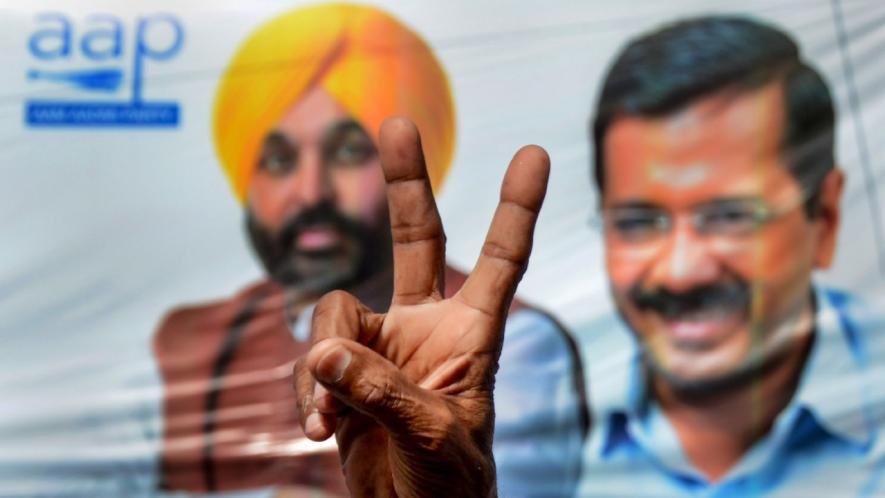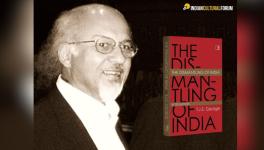In Punjab, Victory and Challenge Come Together for AAP

Image Courtesy: PTI
A few days before the Punjab Legislative Assembly elections, an old man from Dhuri, the constituency of the newly elected Chief Minister, Bhagwant Mann, told me, “Son! All parties are rogues. I have no faith in any. Well, I do have to vote...We have tried two big crooks, now, let us try these small ones…”
Similarly, a cyclist from Amritsar East, where Aam Aadmi Party (AAP) candidate Jeevanjot Kaur defeated Navjot Sidhu and Bikram Singh Majithia, told me, “Sirji, we have seen the Akalis and the Congress. They did nothing for Punjab, especially the poor. This time we will usher in change. I know nothing about the AAP candidate but this time for the sake of Punjab, the broom [AAP’s electoral symbol] will get the votes.”
What these two ordinary men from Punjab said got confirmed in the recent state Assembly election, as it was in the 2019 Lok Sabha election. When the 2019 election was held, people were saddened by the infighting within AAP. Apart from the Congress party, the Akali Dal and its ally Bharatiya Janata Party (BJP) and AAP, a fourth group named the PDA or Punjab Democratic Alliance, was also in the fray. It was a joint force of six parties, including AAP breakaway leader Sukhpal Khaira, Punjab Ekta Party, Dharamvira Gandhi’s Nava Punjab Party, Lok Insaaf Party, Communist Party of India, Revolutionary Marxist Party and the Bahujan Samaj Party (BSP).
Then, too, the people of Punjab had halted the saffron chariot while expressing their displeasure towards their traditional parties. The Congress had won eight out of 13 seats, the Akali Dal-BJP alliance got four seats, of which Badal family members Sukhbir and Harsimrat Kaur won their party’s only two seats. AAP got just one seat in Sangrur. However, the NOTA option had got 1,54,430 votes. The PDA did not win any seats, but its constituents increased their vote shares. For instance, BSP secured the third position on the Anandpur Sahib seat with 1,46,000 votes, got 1,28,000 votes in Hoshiarpur and more than 2,00,000 votes in Jalandhar.
The Lok Insaaf Party came second in Ludhiana and third in Fatehgarh Sahib. Dharamvira Gandhi secured the third position in Patiala with 1,68,000 votes. On the Khadoor Sahib seat, Paramjit Kaur Khalra, wife of the late human rights activist Jaswant Singh Khalra, stood third with more than 2,00,000 votes. The PDA candidates split the votes of those who oppose the traditional political parties in Punjab, which helped the Congress party in the 2019 election. Some political scholars also argue that only two years had gone by since the 2017 Assembly election, which had brought the Congress to power in the state. Therefore, people wanted to give it more time to prove it could perform. Second, people’s anger towards the previous Akali Dal regime had not subsided even in 2019.
This time, no political alliance like the PDA was in the fray in Punjab. As a result, the anger among the people towards both traditional parties, Akali Dal and Congress, could find expression at the polling booth. Indeed, led by traditional parties, Punjab sank economically and in other spheres. The health and education infrastructure of Punjab has completely collapsed in recent decades. People faced obstructions in dealing with government officials, police stations in particular. The attitude of the officialdom towards people has become abusive. Corruption, unemployment, the drugs menace all became dominant, while the drug mafia and sand mafia were seen as sheltered by those in power.
Consequently, youth migrated to foreign countries in large numbers in recent decades. The Congress government formed in 2017 was unable to change this scenario. It did not fulfil its promises to people before coming to power. This contributed to the scenario just before the 2022 Assembly election in which people decided to ‘teach a lesson’ to the traditional parties.
Second, the peasant movement that started in Punjab played a significant role in making the Punjabis aware of the problems of farmers and how government policies are contributing to them. This movement became a kind of university for the people of Punjab, not just a campaign to fight the three agricultural laws. People learned to question the state through this protest. That is why there was opposition to almost every party in many villages of Punjab. This situation proved to be a boon for the AAP.
Professor Bawa Singh, a social analyst from Punjab, believes, “The credit for the success of AAP in Punjab also goes to the farmer movement because during it, in thousands of speeches, people were told to get rid of their traditional parties. Although the large farmer organisations did not participate in the election, AAP did preach that it since is new, people should give it a chance. In this way, Kejriwal and his team caught hold of Aladdin’s lamp in Punjab.”
Not only was AAP at the right place at the right time, but its leaders also widely promoted the ‘Delhi model’ in Punjab. The overall effect of these developments is visible in the result of the state Assembly election. AAP has secured a thumping majority with 92 of 117 seats. The Akali Dal has suffered a historic defeat and landed only three seats, while the Congress party could win only 18 seats. Stalwarts such as Parkash Singh Badal, Sukhbir Badal, Manpreet Badal, Adesh Pratap Singh Kairon, Navjot Sidhu, Captain Amarinder Singh, Charanjit Channi, Rajinder Kaur Bhattal and Bikramjit Majithia had to face crushing defeats, that too from the AAP’s “ordinary” candidates. In this election, traditional parties tried to play the caste-religion card, but people cancelled everything else out and voted for “change”.
Despite having gained power, the road ahead for AAP is not easy. Punjabis would like to see their new government do real work on the ground. The Bhagwant Mann-led government has made some attractive-sounding remarks, such as “the government will now run from villages and cities instead of the capital”. AAP has also told its legislators to remain in their Assembly constituencies rather than live in Chandigarh. An anti-corruption helpline has been set up where people can call in complaints about corrupt officials. Notably, the government has assured that it will amend the pension rules to ensure that former legislators get a pension for only one previous term.
The Mann government has announced that 35,000 contractual employees will be made permanent, but the Congress party had claimed this policy was cleared when it was in power. Criticism of the Bhagwant Mann government has already started on many such issues. For example, the party’s decision to spend Rs. 3 crore on the brief swearing-in ceremony for its MLAs and for spending big money on advertisements in the media, especially in the newspapers circulated and published outside Punjab.
AAP has also been criticised for picking people from outside Punjab, such as Raghav Chadha and Sandeep Pathak, for the Rajya Sabha election. Voices have been raised against its proposals for a bourgeoisie like Ashok Mittal, the wealthy businessman Sanjeev Arora (said to be close to the BJP) and cricketer Harbhajan Singh (who did not support the farmer’s movement) to the Rajya Sabha. On 23 March, the Punjabi daily newspaper ‘Ajit’ reported that instead of informing the people about government or Cabinet decisions through press conferences, a studio has been prepared in the Chief Minister’s Secretariat. Here, the Chief Minister will not answer journalists’ questions but release a recorded message for the media. Many scholars of Punjab are comparing such decisions with ‘Modi’s way’.
Professor Bawa Singh says, “It is a test whether the party can live up to the majority that the people have given it. The biggest challenge for AAP is that it was born with slogans like ‘swaraj’ and ‘internal democracy’ but its big leaders behave like dictators. This party does majoritarian politics on many issues, like the BJP. In Punjab, they held tricolour yatras in Hindu-dominated areas. The party still has no clear understanding of the sensitive issues of Punjab. This kind of attitude cannot last very long in a state like Punjab. Here, a party can run only with a ‘partnership approach’.”
In other words, the Punjabis know how to put a leader on a throne, but they know equally well how to bring them down. It is vital that all leaders remember this.
The author is an independent journalist. The views are personal.
Get the latest reports & analysis with people's perspective on Protests, movements & deep analytical videos, discussions of the current affairs in your Telegram app. Subscribe to NewsClick's Telegram channel & get Real-Time updates on stories, as they get published on our website.
























